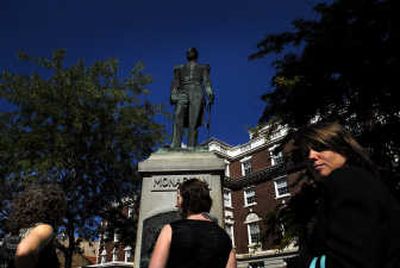Walk back through time

Legend has it that Spokane’s “Great Fire” of 1889 started in a brothel when a lady heating her curling iron tipped over a lamp.
Or it could have been a grease fire in the kitchen.
No one is really sure.
Either way, the fire on Aug. 4 swept north to northeastward and destroyed 32 blocks of the fledgling city, setting the stage for a dramatic building boom.
Probably only a few current residents could tell you where the fire started, even though a commemorative plaque identifies the location on the east side of Lincoln Street just north of the railroad viaduct.
The plaque says the blaze started in a boarding house and spread in part because the city’s new water system failed.
Mounted on a low pedestal next to the curb, the plaque “is so unassuming you could have walked by it a hundred times and not even noticed it,” said Aimee Flinn, specialist with the city-county historic preservation office.
Now, a new heritage walking-tour brochure is available that shows the location of the plaque and nearly 60 other historic sites, buildings and districts in the downtown area.
The Downtown Spokane Heritage Walk brochure is available at the Spokane Convention and Visitors Bureau, 201 W. Main Ave.; on the third floor of City Hall; and at the Web site for the city-county historic preservation office at www.historicspokane.org/.
It was financed through a $20,000 grant from the National Park Service’s Preserve America program. Spokane was designated a Preserve America city in 2005.
While the brochure doesn’t clear up the origin of the “Great Fire,” it provides plenty of information for residents and visitors who want to take the self-guided tour.
For example, the brochure recommends visiting the old steam plant at 815 W. Railroad Ave. and taking a look up to the hole in the top of one of the towering smokestacks.
It also tells the history of the old Ritz Theater at 520 W. Main Ave., an Italian Renaissance-style building that opened in 1924 with seating for 550 people on the main floor and in the balcony. Today, it houses Rocky Rococo pizza.
The Realty Building at 242 W. Riverside Ave. was the first home of KREM-TV in 1947, according to the brochure.
A Mother’s Day sermon inside Central Methodist Church at 221 S. Howard St. in 1909 inspired Sonora Smart Dodd to come up with the idea of the first Father’s Day in June of the following year to honor her father.
The brochure has been popular since its introduction in June. The Convention and Visitors Bureau went through a case in less than a month, and the historic preservation office’s Web site is getting about 70 “hits” each week. The brochure can be downloaded in PDF format.
“Our main audience is going to be visitors,” said Flinn.
The heritage walk was developed over the past year in a cooperative effort of the city-county historic preservation office, the Convention and Visitors Bureau, the Downtown Spokane Partnership and the Northwest Museum of Arts and Culture.
Design and production were turned over to the BHW1 advertising agency in Spokane.
The Preserve America program supports community efforts to enhance cultural and natural-history assets as a way to increase a community’s pride in its past as well as promote the economic opportunities created by historic preservation.